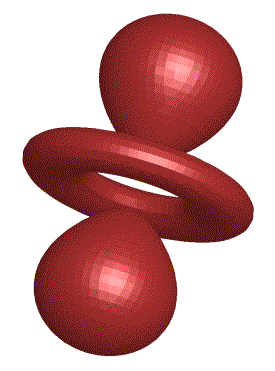The SPHER_HARM function returns the value of the spherical harmonic Ylm(θ,φ), which is a function of the longitude φ and the colatitude θ on a sphere (the colatitude is 90°–latitude). The degree l and order m have the following constraints: –l ≤ m ≤ l, l ≥ 0.
The spherical harmonics are related to the associated Legendre polynomial by:

For negative m the following relation is used:

where * represents the complex conjugate.
This routine is written in the IDL language. Its source code can be found in the file spher_harm.pro in the lib subdirectory of the IDL distribution.
Syntax
Result = SPHER_HARM( Theta, Phi, L, M, [, /DOUBLE] )
Return Value
SPHER_HARM returns a complex scalar or array containing the value of the spherical harmonic function. The return value has the same dimensions as the input arguments Theta and Phi. If one argument (Theta or Phi) is a scalar and the other argument is an array, the function uses the scalar value with each element of the array, and returns an array with the same dimensions as the input array.
If either Theta or Phi are double-precision or if the DOUBLE keyword is set, the result is double-precision complex, otherwise the result is single-precision complex.
Arguments
Theta
The value of the polar (colatitudinal) coordinate θ at which Ylm(θ,φ) is evaluated. Theta can be either a scalar or an array.
Phi
The value of the azimuthal (longitudinal) coordinate φ at which Ylm(θ,φ) is evaluated. Phi can be either a scalar or an array.
L
A scalar integer, L ≥ 0, specifying the order l of Ylm(θ,φ). If L is of type float, it will be truncated.
M
A scalar integer, –L≤M≤L, specifying the azimuthal order m of Ylm(θ,φ). If M is of type float, it will be truncated.
Keywords
DOUBLE
Set this keyword to force the computation to be done in double-precision arithmetic.
Example
This example visualizes the electron probability density for the hydrogen atom in state 3d0. (Feynman, Leighton, and Sands, 1965: The Feynman Lectures on Physics, Calif. Inst. Tech, Ch. 19). The first part of this example defines the data and converts it from rectangular to spherical:
n = 1511L
a = 60*FINDGEN(n)/(n-1) - 29.999
x = REBIN(a, n, n, n)
y = REBIN(REFORM(a,1,n), n, n, n)
z = REBIN(REFORM(a,1,1,n), n, n, n)
spherCoord = CV_COORD(FROM_RECT= $
TRANSPOSE([[x[*]],[y[*]],[z[*]]]), /TO_SPHERE)
phi = REFORM(spherCoord[0,*], n, n, n)
theta = REFORM(!PI/2 - spherCoord[1,*], n, n, n)
r = REFORM(spherCoord[2,*], n, n, n)
L = 2
M = 0
angularState = SPHER_HARM(theta, phi, L, M)
radialFunction = EXP(-r/2)*(r^2)
waveFunction = angularState*radialFunction
probabilityDensity = ABS(waveFunction)^2
SHADE_VOLUME, probabilityDensity, $
100*MEAN(probabilityDensity), vertex, poly
oPolygon = OBJ_NEW('IDLgrPolygon', vertex, $
POLYGON=poly, COLOR=[180,50,50])
XOBJVIEW, oPolygon
The results are shown in the following figure (rotated in XOBJVIEW for clarity):

Version History
See Also
LEGENDRE, LAGUERRE